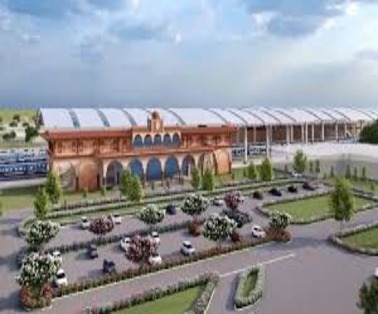Prime Minister Narendra Modi laid the foundation stone for the redevelopment of 508 Railway Stations across the country as a part of Amrit Bharat Station Scheme
Key Points on the Amrit Bharat Station Scheme
- The extensive redevelopment project is estimated to cost more than RS 24,470 crores
- These 508 stations are spread across 27 states and union territories
- Including 55 each in Uttar Pradesh and Rajasthan, 49 in Bihar, 44 in Maharashtra, 37 in West Bengal, 34 in Madhya Pradesh, 32 in Assam, 25 in Odisha, 22 in Punjab, 21 each in Gujarat and Telangana, 20 in Jharkhand, 18 each in Andhra Pradesh and Tamil Nadu, 15 in Haryana, 13 in Karnataka among others.
What is Amrit Bharat Station Scheme?
- It was launched in February 2023 by the Ministry of Railways
- The ABSS envisages the development of stations on a continuous basis with a long-term approach
- The scheme is based on the principle of ‘City Centres’, which means that the railway stations will be developed as hubs of urban activity and connectivity, with proper integration of both sides of the city.
- The scheme also envisages the participation of private sector, state governments and local bodies in the redevelopment process.
- The scheme was launched to redevelop 1,309 stations across the country and is based on Master Planning for long term
Key Objectives of the Amrit Bharat Station Scheme
- To go beyond Minimum Essential Amenities (MEA) to provide passengers with enhanced services.
- To create lively community spaces with the help of Roof Plazas and city centres within stations, creating.
- To introduce new amenities and upgrading or replacing existing ones, boosting overall station quality.
- To optimises resource allocation.by prioritising stakeholder requirements based on station usage studies, Amrit Bharat Station Scheme
Extensive Scope of Work under the Amrit Bharat Station Scheme
- Enhanced Entrances: Transforming entrance porches into visually appealing, welcoming spaces.
- Optimised Structures: Relocating old buildings strategically to maximise space for passenger activities.
- Passenger Comfort: Providing combined waiting halls, well-equipped cafeterias, and retail facilities for passenger convenience.
- Local Product Showcase: Allocate space for “One Station One Product” stalls, promoting regional products and economies.
- Premium Facilities: Executive Lounges and spaces for small business meetings to cater to diverse passenger needs.
- Effective Signage: Implementing clear and informative signage to enhance navigation within stations.
- Infrastructure Enhancement: Improving station approaches, roads, pedestrian pathways, parking, and lighting.
- Aesthetic Touch: Incorporating landscaping, green spaces, and local art to enhance the station experience.
- 9. Technological Upgrades: Installing high-level platforms, ballastless tracks, free WiFi, and earmarked spaces for future 5G towers.
- Universal Accessibility: Ensuring amenities for Divyangjan, ensuring inclusivity for all passengers.
- Modern and Durable Infrastructure: Incorporating durable materials, comfortable furniture, and efficient public announcement systems.
Significance of the Amrit Bharat Station Scheme
- The Amrit Bharat Station Scheme signifies a monumental leap towards revitalising Indian Railways.
- With its focus on transforming stations into efficient, comfortable hubs, Amrit Bharat Station Scheme ensures that passengers across states enjoy seamless travel experiences.
- By amalgamating cutting-edge amenities, thoughtful design, and efficient planning, the scheme contributes to India’s journey towards progress and prosperity, one station at a time.
Need for the Amrit Bharat Station Scheme
- India Railways is an integral part of the nation’s transportation infrastructure.
- In a bid to keep it safe for passengers as well as freight transportation, it is essential to modernise its infrastructure with latest technologies, amenities and others from time to time.
- In this context, the government is working to transform the railway stations across the country in line with its vision of ‘Naya Bharat’/ New India.
Indian Railways
- The Indian Railways was established on 16th April 1853. The inaugural passenger train covered a 34-kilometer route between Mumbai’s Bori Bandar and Thane.
- The Indian Railways ranks as the world’s fourth-largest railway network, encompassing a track length of 67,368 km.
- Only the US, China, and Russia have larger networks. It’s also the world’s second-largest network managed under a single administration, spanning 115,000 km.
- The Indian Railways has four UNESCO-recognized world heritage sites, Darjeeling Himalayan Railway, Chhatrapati Shivaji Terminus in Mumbai, Nilgiri Mountain Railway, and Kalka Shimla Railway.
- Hubli Junction’s Platform number 1, also known as Shree Siddharoodha Swamiji Hubballi Junction in Karnataka, holds the record for the world’s longest railway platform at 1,505 meters.
- The longest train ride in India is the Vivek Express, traveling from Kanyakumari to Dibrugarh, covering a distance of 4,189 kilometers with 56 stops in 82 hours and 30 minutes.
- The shortest train ride is just 3 kilometers, running between Nagpur and Ajni.
- India is home to the Chenab Rail Bridge, the world’s highest railway bridge, located in Dharot, Jammu, and Kashmir
To Download Monthly Current Affairs PDF Click here
Get Inspiration from CLAT 2025 Topper
Click here to get a free demo
Everything About CLAT 2025



